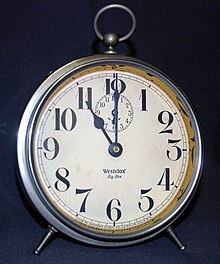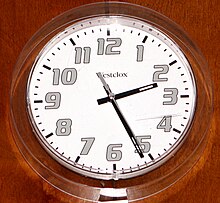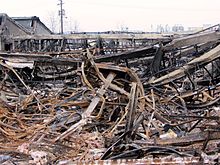| This article needs additional citations for verification. Please help improve this article by adding citations to reliable sources. Unsourced material may be challenged and removed. Find sources: "Westclox" – news · newspapers · books · scholar · JSTOR (June 2009) (Learn how and when to remove this message) |
 A Westclox "Big Ben" alarm clock A Westclox "Big Ben" alarm clock | |
| Formerly | United Clock Company Western Clock Company Western Clock Manufacturing Company (1888–1919) Western Clock Co., Ltd. (1919-1931) merged to become General Time Corporation |
|---|---|
| Headquarters | 320 5th Street, Peru, Illinois, United States |
| Website | nylholdings |
Westclox was an American manufacturer and is a current brand of clocks and alarm clocks. The company's historic plant is located in Peru, Illinois.
Early history as United Clock Company
Charles Stahlberg and others from Waterbury, Connecticut, formed the "United Clock Company" on December 5, 1885, in Peru, Illinois, intending to manufacture clocks based on a technological innovation by Stahlberg. Stahlberg patented this innovation on September 22, 1885, (US patent #326,602) which involved the use of molded lead alloy movement plates with inset brass bushings as well as lead alloy gear assemblies. Shortly after receiving the 1885 patent, United Clock Company went bankrupt, and there are no known surviving examples of the patented clock.

Bankruptcies, reorganizations, and mergers
In 1887, the company reorganized under the new name Western Clock Company and again went bankrupt, and F. W. Matthiessen reorganized it in 1888 as the Western Clock Manufacturing Company. In 1908, the company received a patent for the "Big Ben" alarm clock movement. This movement has a "bell-back" design, meaning that the bell mechanism is integral to the clock's case. The company first brought the Big Ben to market in 1909. The company's name was shortened to "Western Clock Company" in 1912. In 1910, the Big Ben became the first alarm clock advertised nationally, with ads placed in the Saturday Evening Post.
The modern trademark of the company, "Westclox," first appeared on the back of Big Ben alarm clocks from 1910 to 1917. The name appeared on Big Ben dials as early as 1911. The company officially registered this trademark on January 18, 1916.
In 1919, Western Clock Co., Ltd., was incorporated. Twelve years later, in 1931, the company merged with the Seth Thomas Clock Company, with both companies becoming divisions of General Time Corporation. The Westclox unit became known as "Westclox Division of General Time Corporation" in 1936.

In 1938, Westclox introduced its first portable travel alarm clock to the market.
World War II wartime efforts
During World War II, Westclox and other General Time Corporation subsidiaries produced aviation instrumentation and control components, compasses for the United States Army, and clocks for the United States Navy. Westclox became a major manufacturer of fuzes for military ordnance. Clocks for the civilian market stopped production in 1942.
Beginning in 1943, Westclox and other companies introduced clocks for the civilian market that used much less brass than previously. Clocks were labeled as "Waralarm" by Westclox and only referenced city of origin; no mention of maker appeared. Other clock companies also produced clocks that were labeled "War Alarm", such as Gilbert and Telechron. Price was set by the Office of Price Management at $1.65.
Production of civilian models resumed in 1946.
Watches
The Westclox company was a major manufacturer of dollar watches. It started production of an inexpensive, back-winding pocket watch in 1899, which was intended to be affordable to any working person. The company continued to produce cheap pocket watches into the 1990s.
Late 20th-century developments
In 1959, Westclox introduced and patented its "drowse" alarm, which was one of the first of its kind powered by electricity, which integrated what is now more commonly known as a "snooze" function. Talley Industries acquired General Time in 1968. Westclox introduced its first quartz movement in 1972. In 1988, the management of Talley Industries purchased General Time from the company. Another bankruptcy shortly followed, and Salton, Inc. acquired the "Westclox", "Big Ben", and "Spartus" trademarks in 2001.

In October 2007, Salton sold its entire time products business, including the Westclox and Ingraham trademarks, to NYL Holdings LLC.
2012 New Year's Fire

In the early morning of January 1, 2012, a fire broke out at the Westclox factory in Peru, Illinois. The fire destroyed about 25% of the structure. Two teens were charged with aggravated arson; Steven M. Gallacher (then 17) of LaSalle, Illinois, and an unidentified minor (then 16). The fire required firefighters and police from 20 surrounding municipalities to extinguish. One firefighter, LaSalle fireman Steve Smith, sustained a career-ending injury when a firehose attached to a hydrant popped loose and the metal coupling on the end hit him in the leg. Gallacher was convicted of aggravated arson on October 11, 2012, with a sentence of 6–30 years without the possibility of parole. Gallacher's sentence of aggravated arson was the direct result of the fire plus Smith's injury.
See also
References
- "Company News: Salton Buying Westclox, Big Ben and Spartus Brands". The New York Times. Bloomberg News. August 8, 2001. Retrieved December 8, 2017.
- "Summary of SALTON INC – Yahoo! Finance". November 13, 2007. Retrieved October 22, 2008.
- Collins, Tom (October 11, 2012). "Westclox fire suspect convicted". NewsTribune. LaSalle, Illinois. Retrieved December 8, 2017.
External links
- Historic American Engineering Record (HAER) No. IL-83, "Western Clock Company, Peru Factory"
- Clockhistory.com: History of Westclox
- The Westclox Museum: Located in the old factory at Peru, Illinois, USA
- Clock manufacturing companies of the United States
- Clock brands
- Manufacturing companies established in 1885
- Manufacturing companies disestablished in 2001
- 1885 establishments in Illinois
- 2001 disestablishments in Illinois
- Buildings and structures in LaSalle County, Illinois
- Historic American Engineering Record in Illinois
- Peru, Illinois
- Defunct manufacturing companies based in Illinois